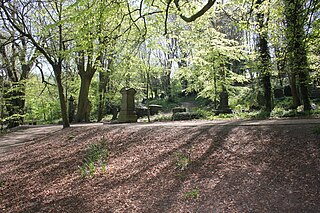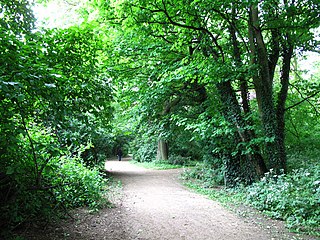
The Borough of Stockton-on-Tees is a unitary authority with borough status in the counties of County Durham and North Yorkshire, England. The borough had a population of 196,600 in 2021.

West Hartlepool was a predecessor of Hartlepool, County Durham, England. It developed in the Victorian era and took the name from its western position in the parish of what is now known as the Headland.

Tower Hamlets Cemetery Park is a local nature reserve and historic cemetery in the London Borough of Tower Hamlets within the East End of London. It is regarded as one of the seven great cemeteries of the Victorian era, the "Magnificent Seven", instigated because the normal church burial plots had become overcrowded.

Spion Kop is a colloquial name or term for a number of single-tier terraces and stands at sports stadiums, particularly in the United Kingdom. The steep nature resembles the Spion Kop, a hill near Ladysmith, South Africa, which was the scene of the Battle of Spion Kop in January 1900 during the Second Boer War.

The Battle of Spioen Kop was a military engagement between British forces and two Boer Republics, the South African Republic and the Orange Free State, during the campaign by the British to relieve the besieged city Ladysmith during the initial months of the Second Boer War. The battle was fought 23–24 January 1900 on the hilltop of Spioen Kop(1), about 38 km (24 mi) west-southwest of Ladysmith and resulted in a Boer victory.

John Dobson was a 19th-century English neoclassical architect. During his life, he was the most noted architect in Northern England. He designed more than 50 churches and 100 private houses, but he is best known for designing Newcastle railway station and his work with Richard Grainger developing the neoclassical centre of Newcastle. Other notable structures include Nunnykirk Hall, Meldon Park, Mitford Hall, Lilburn Tower, St John the Baptist Church in Otterburn, Northumberland, and Beaufront Castle.

Nunhead Cemetery is one of the Magnificent Seven cemeteries in London, England. It is perhaps the least famous and celebrated of them. The cemetery is located in Nunhead in the London Borough of Southwark and was originally known as All Saints' Cemetery. Nunhead Cemetery was consecrated in 1840 and opened by the London Cemetery Company. It is a Local Nature Reserve.

The General Cemetery in the City of Sheffield, England opened in 1836 and closed for burial in 1978. It was the principal cemetery in Victorian Sheffield with over 87,000 burials. Today it is a listed Landscape on the English Heritage National Register of Historic Parks and Gardens. It is also a Local Nature Reserve. It is owned by the City of Sheffield and managed on behalf of the city by a local community group, the Sheffield General Cemetery Trust.

Vvedenskoye Cemetery is a historic cemetery in Lefortovo District of Moscow in Russia.

Hartlepool Rovers F.C. are a rugby union club who play at The New Friarage, West View Road in Hartlepool. The club play in Durham/Northumberland 1, the seventh tier of the English rugby union system after being relegated from North One East at the end of the 2010–11 season. Steve Smith is the club's player-coach and Steven Barnfield its captain. Rovers have a thriving junior section including boys’ and girls’ teams. Hartlepool Rovers also have a thriving and successful women's team, with Rovers Ladies having just completed their first league campaign in the Women's NC North 2 East. They are by far the most successful club in local cup rugby, having won the Durham Senior Cup a record 45 times.

The A178 is a road that runs from Hartlepool in County Durham to Middlesbrough in North Yorkshire, England.

Spioenkop Dam Nature Reserve or Spion Kop Nature Reserve is a protected area in KwaZulu-Natal, South Africa. It lies close to Ladysmith with Winterton being the closest town, and is about 4,400 hectares (17 sq mi). The historic battlefield site can be reached by road.

Jesmond Old Cemetery is a Victorian cemetery in Newcastle upon Tyne, United Kingdom, founded in 1834. It contains two Grade II listed buildings and seven Grade II listed monuments as well as the graves of dozens of notable people from the history of Tyneside. The cemetery was designed by John Dobson who was himself later buried in the cemetery.

Spion Kop (1917–1941) was an Irish-bred, British-trained Thoroughbred racehorse and sire. In a career that lasted from 1919 until 1921, Spion Kop ran fourteen times winning two races. After an undistinguished early career in which he lost his first six races, he improved as a three-year-old to win The Derby in record time in 1920. After his retirement from racing he had some success as a stallion.

Spion Kop is a mountain in the province of KwaZulu-Natal, South Africa. It is located near the town of Ladysmith, 27 km to the WSW and about 2.5 km to the north of the Spioenkop Dam, a reservoir for the waters of the Tugela River.

New Southgate Cemetery is a 22-hectare cemetery in Brunswick Park in the London Borough of Barnet. It was established by the Colney Hatch Company in the 1850s and became the Great Northern London Cemetery, with a railway service running from near Kings Cross station to a dedicated station at the cemetery, similar to the service of the London Necropolis Company to Brookwood Cemetery in Surrey.

St John's Wood Church Grounds is a disused graveyard which is now a public park in St. John's Wood in London. It is a Site of Borough Importance for Nature Conservation, Grade 1, and the only Local Nature Reserve in the City of Westminster. Since 2004 it has received the Green Flag Award for excellent green spaces. It is owned and managed by Westminster Council.

Hull General Cemetery was established by a private company in 1847 on Spring Bank in the west of Kingston upon Hull, East Riding of Yorkshire, England. In 1862 the Hull Corporation established a cemetery adjacent, now known as Western Cemetery, and in c. 1890 expanded the cemetery west across Chanterlands Avenue onto an adjacent site.
George Horsley was a Hartlepool ship-owner, alderman and mayor of Hartlepool in 1875 and 1876.

Stranton Grange Cemetery is located in Tanfield Road, Stranton, Hartlepool. It is also the site of Hartlepool Crematorium. It opened in May 1912. It now covers over 30 acres in extent.




















